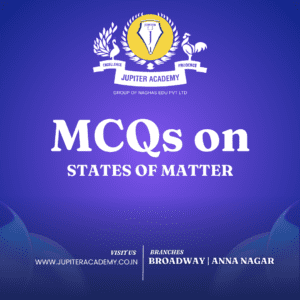NEET 2025: OMR Sheet Filling Tips to Avoid Mistakes Preparing...
Read MoreMCQs on States of Matter for NEET

The three basic states in which a matter can exist are solid, liquid and gas. A matter can exist in one or more than one state, e.g. water exists in all three states. The state of a matter depends on the intermolecular forces and arrangement of molecules. The chemical property of a substance remains the same, irrespective of its state but the rate of reaction changes with the change in the physical state. On increasing and decreasing the temperature or pressure, one state of a matter gets converted to another state. Apart from these, there are two other states of matter known as Plasma and Bose-Einstein Condensate.
Sure, here are some multiple-choice questions (MCQs) on the States of Matter for NEET (National Eligibility cum Entrance Test):
1. Which of the following statements about the states of matter is correct?
a) Solids have a definite shape and volume.
b) Gases have a definite shape but no definite volume.
c) Liquids have neither a definite shape nor a definite volume.
d) Gases have a definite shape and volume.
2. The process of changing a gas into a liquid is called:
a) Condensation
b) Evaporation
c) Sublimation
d) Melting
3. The property that allows a liquid to flow and take the shape of its container is known as:
a) Compressibility
b) Viscosity
c) Density
d) Fluidity
4. At absolute zero temperature, a substance exists in which state of matter?
a) Solid
b) Liquid
c) Gas
d) Plasma
5. Which of the following is an example of a physical change in the state of matter?
a) Rusting of iron
b) Burning of wood
c) Melting of ice
d) Cooking an egg
6. The temperature at which a solid changes into a liquid at atmospheric pressure is called:
a) Boiling point
b) Freezing point
c) Melting point
d) Condensation point
7. The intermolecular forces are strongest in which state of matter?
a) Solid
b) Liquid
c) Gas
d) Plasma
8. Which of the following processes is an example of sublimation?
a) Ice melting into water
b) Water evaporating into steam
c) Dry ice turning into carbon dioxide gas
d) Liquid nitrogen boiling into nitrogen gas
9. Which gas law states that the pressure of a gas is inversely proportional to its volume at constant temperature?
a) Boyle’s law
b) Charles’s law
c) Gay-Lussac’s law
d) Avogadro’s law
10. The critical point of a substance refers to:
a) The temperature at which it turns into a gas
b) The pressure at which it turns into a liquid
c) The point where all three states of matter coexist
d) The highest temperature it can reach
Answers:
1. a) Solids have a definite shape and volume.
2. a) Condensation
3. d) Fluidity
4. a) Solid
5. c) Melting of ice
6. c) Melting point
7. a) Solid
8. c) Dry ice turning into carbon dioxide gas
9. a) Boyle’s law
10. c) The point where all three states of matter coexist
Sure, here are some multiple-choice questions (MCQs) on States of Matter for JEE MAINS:
1. Which of the following statements is true about the kinetic theory of gases?
a) Gases consist of large, closely-packed particles.
b) Gas particles have strong intermolecular forces.
c) The average kinetic energy of gas particles is directly proportional to the absolute temperature.
d) Gas particles have fixed positions in a container.
2. Which of the following is a characteristic property of a gas?
a) Definite shape and volume
b) Definite shape, but indefinite volume
c) Indefinite shape and volume
d) Indefinite shape, but definite volume
3. Which gas law states that the volume of a given amount of gas is inversely proportional to its pressure at constant temperature?
a) Boyle’s law
b) Charles’s law
c) Gay-Lussac’s law
d) Avogadro’s law
4. At what temperature do Celsius and Fahrenheit scales show the same numerical value?
a) -40
b) 0
c) 32
d) 100
5. The process of a substance directly changing from a solid to a gas is called:
a) Evaporation
b) Condensation
c) Sublimation
d) Deposition
6. Which of the following substances has the highest boiling point?
a) Water
b) Ethanol
c) Methane
d) Oxygen
7. The triple point of water is:
a) 0°C and 1 atm
b) 100°C and 1 atm
c) -273.15°C and 1 atm
d) 0°C and 0 atm
8. The critical point of a substance is the temperature and pressure above which:
a) The substance exists as a gas only
b) The substance exists as a liquid and a gas can coexist
c) The substance exists as a solid and a gas can coexist
d) The substance exists as a solid only
9. Which of the following gases exhibits the strongest intermolecular forces?
a) Nitrogen (N2)
b) Hydrogen (H2)
c) Oxygen (O2)
d) Carbon dioxide (CO2)
10. Which state of matter has a definite shape and volume?
a) Solid
b) Liquid
c) Gas
d) Plasma
Answers:
1. c) The average kinetic energy of gas particles is directly proportional to the absolute temperature.
2. c) Indefinite shape and volume
3. a) Boyle’s law
4. a) -40
5. c) Sublimation
6. a) Water
7. a) 0°C and 1 atm
8. b) The substance exists as a liquid and a gas can coexist
9. d) Carbon dioxide (CO2)
10. a) Solid
TN Medical 2024 Counseling: Extension of Round 2 for MBBS & BDS
TN Medical 2024 Counseling: Extension of Round 2 for MBBS...
Read MoreTENTATIVE ROUND-II COUNSELLING SCHEDULE FOR ADMISSION TO MBBS/BDS
Registration Starts from 11-09-2024 10:00 A.M to 13-09-2024 05:00 P.M....
Read MoreMCQs on States of Matter for NEET MCQs on States of Matter for NEET MCQs on States of Matter for NEET MCQs on States of Matter for NEET MCQs on States of Matter for NEET MCQs on States of Matter for NEET MCQs on States of Matter for NEET MCQs on States of Matter for NEET MCQs on States of Matter for NEET MCQs on States of Matter for JEE MCQs on States of Matter for JEE MCQs on States of Matter for JEE MCQs on States of Matter for JEE MCQs on States of Matter for JEE






